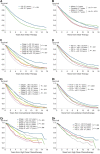Myeloma in patients younger than age 50 years presents with more favorable features and shows better survival: an analysis of 10 549 patients from the International Myeloma Working Group
- PMID: 18268097
- PMCID: PMC4259800
- DOI: 10.1182/blood-2007-03-081018
Myeloma in patients younger than age 50 years presents with more favorable features and shows better survival: an analysis of 10 549 patients from the International Myeloma Working Group
Abstract
We analyzed the presenting features and survival in 1689 patients with multiple myeloma aged younger than 50 years compared with 8860 patients 50 years of age and older. Of the total 10 549 patients, 7765 received conventional therapy and 2784 received high-dose therapy. Young patients were more frequently male, had more favorable features such as low International Staging System (ISS) and Durie-Salmon stage as well as less frequently adverse prognostic factors including high C-reactive protein (CRP), low hemoglobin, increased serum creatinine, and poor performance status. Survival was significantly longer in young patients (median, 5.2 years vs 3.7 years; P < .001) both after conventional (median, 4.5 years vs 3.3 years; P < .001) or high-dose therapy (median, 7.5 years vs 5.7 years; P = .04). The 10-year survival rate was 19% after conventional therapy and 43% after high-dose therapy in young patients, and 8% and 29%, respectively, in older patients. Multivariate analysis revealed age as an independent risk factor during conventional therapy, but not after autologous transplantation. A total of 5 of the 10 independent risk factors identified for conventional therapy were also relevant for autologous transplantation. After adjusting for normal mortality, lower ISS stage and other favorable prognostic features seem to account for the significantly longer survival of young patients with multiple myeloma with age remaining a risk factor during conventional therapy.
Figures



References
-
- Wisloff F, Andersen P, Andersson TR, et al. Has the incidence of multiple myeloma in old age been underestimated? The Myeloma project of health region I in Norway. Euro J Haematol. 1991;47:33–337. - PubMed
-
- Bergsagel D. The incidence and epidemiology of plasma cell neoplasms. Stem Cells. 1995;13:1–9. - PubMed
-
- Corso A, Klersy C, Lazzarino M, Bernasconi C. Multiple myeloma in younger patients:the role of age as prognostic factor. Ann Haematol. 1998;76:67–73. - PubMed
-
- Blade J, Kyle RA, Greipp PR. Presenting features and prognosis in 72 patients with multiple myeloma who were younger than 40 years. Br J Haematol. 1996;93:345–351. - PubMed
-
- Bacher U, Kern W, Schnittger S, Hiddemann W, Haferlach T, Schoch C. Population-based age-specific incidences of cytogenetic subgroups of acute myeloid leukemia. Haematologica. 2005;90:1502–1510. - PubMed
Publication types
MeSH terms
LinkOut - more resources
Full Text Sources
Medical
Research Materials
Miscellaneous

